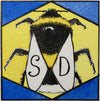Butterfly Conservation Card
All of the plants on this Butterfly Conservation card are very good sources of nectar for bees, butterflies and moths. Two particularly strong nectar sources are marjoram and hemp-agrimony.
Marjoram – 20 species use it as a foodplant
Yarrow – 39 species of butterfly and moth use it as a foodplant: but preferably the white flowered native not its coloured cultivars
Common Bird’s-foot-trefoil – 45 species as a foodplant
Field Scabious (not its cultivars) – 13 species as a foodplant
Wild Thyme – 36 species as a foodplant
Wild Carrot – 24 species as a foodplant
Hemp-agrimony (not the introduced Eupatorium from America) – 17 species as a foodplant
Meadowsweet – 26 species as a foodplant
Common Restharrow – 20 species as a foodplant
Common Rock-rose (the native yellow flowered one) – 21 species as a foodplant
Wild Strawberry – 23 as a foodplant
Common Knapweed - Centaurea nigra, not cultivars. being a source of good quality nectar. And as well as supporting butterflies it supports bees and beetles its seeds provide food for many birds.
Devil's-bit Scabious
Nettle – many species lay eggs on these
Ivy - provides a lifeline to moths, butterflies and other pollinators as it flowers late in the year when other nectar sources are unavailable
Buddleia – a very good nectar source. Take advice about how to manage and control this if needed.
Log piles with bark on - for butterflies and moths to hibernate. Some moths breed in dead wood too.
